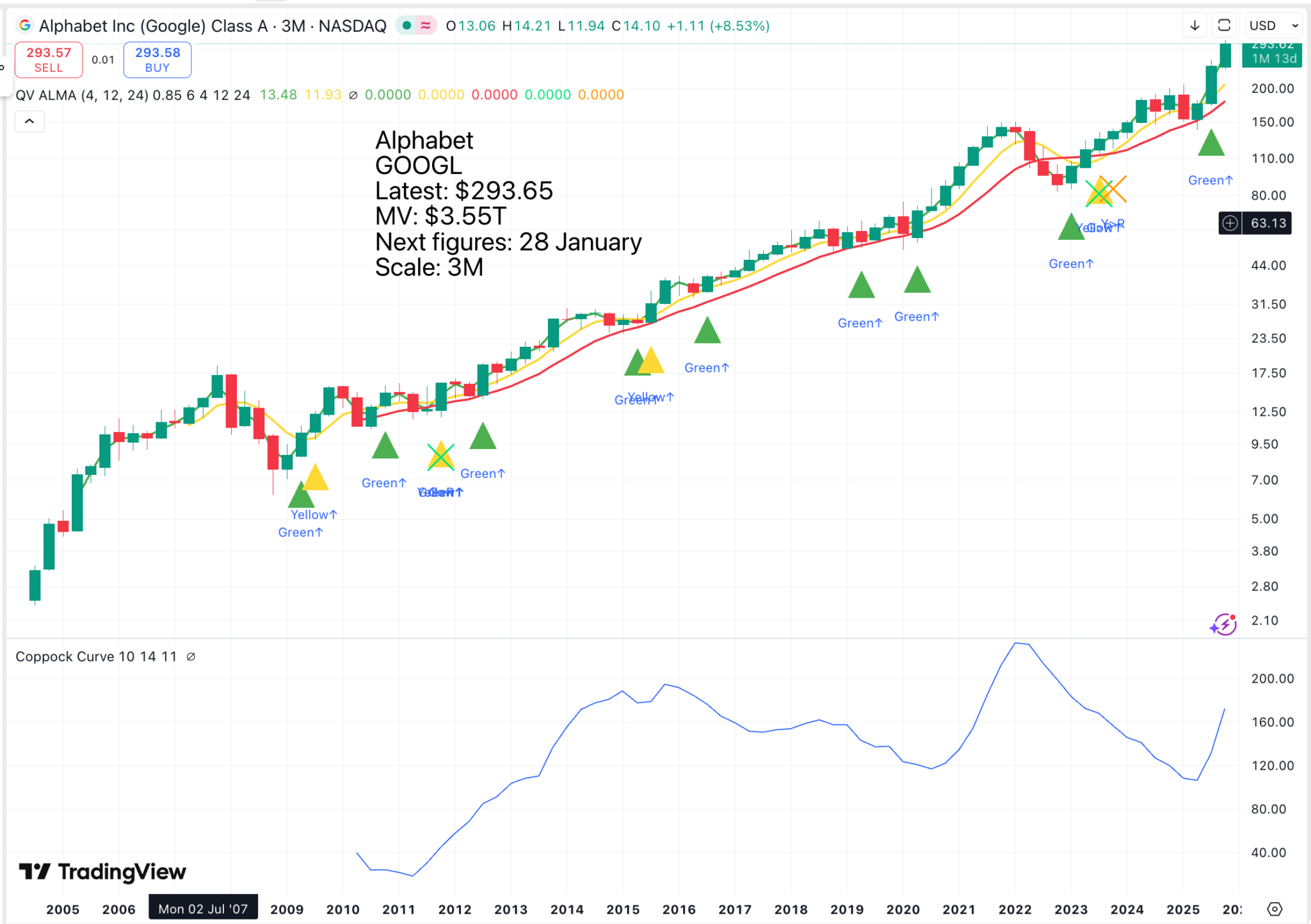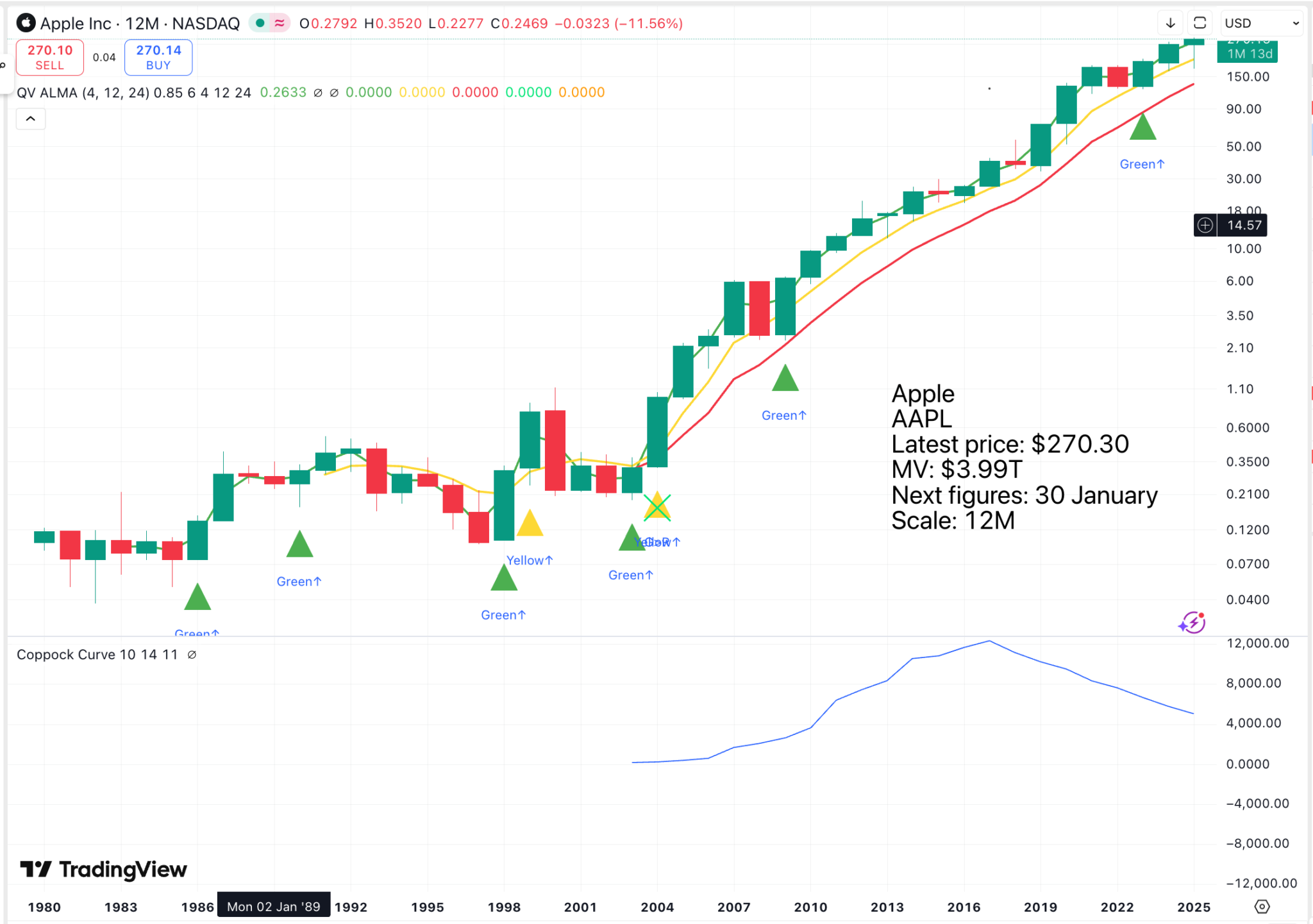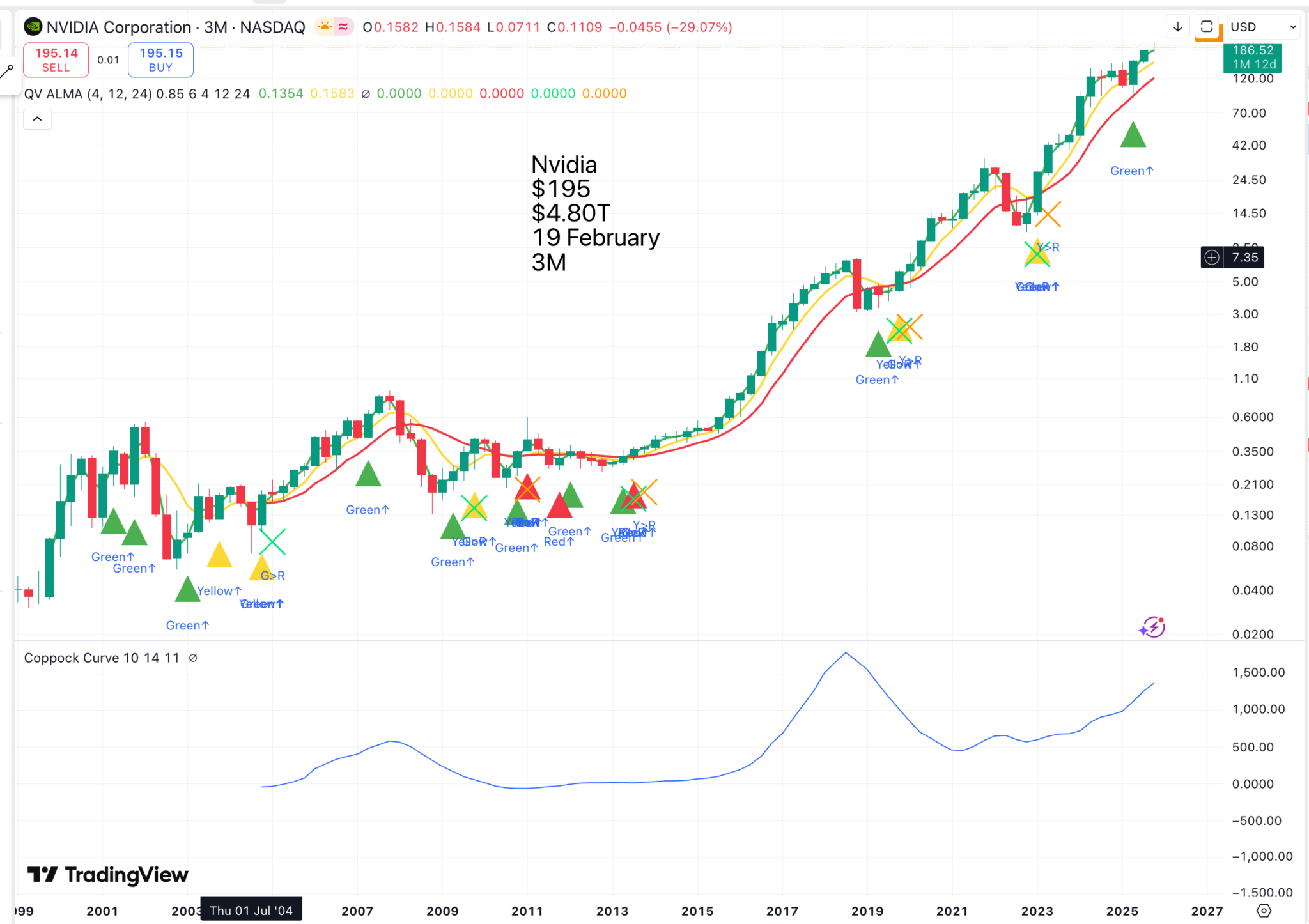

Alphabet/ Google is going through the roof, almost doubling over the last three quarters. Warren Buffett’s Berkshire Hathaway is on board with a $4.9bn stake. Buffett must be happy because Apple, in which he has a huge stake, is also doing well. No sign that the old maestro is losing his touch.
According to my new best friend, this is why Alphabet shares are doing so well.
Alphabet’s shares are performing well due to strong financial results, aggressive leadership in artificial intelligence (AI), the continued growth and profitability of Google Cloud, and a significant investment from Berkshire Hathaway, which has boosted investor confidence.
Factors contributing to the stock’s success include:
Strong Financial Performance: Alphabet has exceeded expectations with double-digit revenue growth in key areas, such as Search and YouTube ads. The company recently had its first $100 billion quarter, and profit grew faster than revenue.
AI Advancements and Monetization: Investors have reacted positively to Google’s “full-stack approach to AI”. The recent launch of its new Gemini 3 AI model, integrated into search and other products, is seen as an advantage over competitors and is driving user engagement.
Google Cloud Momentum: Google Cloud continues to perform well, with increased sales and margins. Strong demand for AI-related infrastructure and services has led to a large backlog and increased market share.
Increased Capital Expenditure: Alphabet has increased its capital expenditure forecasts to meet demand for its AI and cloud services, committing to build new data centers. Investors see this spending as a necessary investment for long-term dominance.
High-Profile Institutional Investment: Berkshire Hathaway disclosed a new, multi-billion dollar stake in Alphabet. This has been interpreted as a vote of confidence in Alphabet’s long-term growth prospects.
Favorable Analyst Sentiment: Analysts have upgraded ratings and raised price targets for Alphabet stock, with a consensus “Strong Buy” rating.
Concerns about AI disrupting its core search business have diminished. A favorable antitrust ruling has allowed the market to focus on Alphabet’s fundamentals and growth potential in areas like AI and autonomous driving through its Waymo unit.
AI overview, 19 November 2025
It is a salutary lesson to think that if I had made Google, as it then was, a punch card investment, my original holding would be worth $164 million. Oh, to have my life over again.
It is interesting to look at a chart where each candlestick represents 12 months.

The automated buy signals, based on moving averages, worked well, but there are also two huge chart breakouts. Alphabet was a screaming buy in 2013 and 2024. If I had kept my holdings, I could have loaded up with more on each of those breakouts and would be stepping out of my private jet at Davos.
I have found a story that does a better job than anything I could do in explaining why Alphabet is such a great investment.
Alphabet’s latest quarterly earnings delivered the goods, beating Wall Street analysts’ expectations on both the top and bottom lines.
The consensus among analysts covering Alphabet stock was for revenue of about $100 billion. Strong advertising sales at Google and YouTube, and robust demand for artificial intelligence compute power at Google Cloud, resulted in revenue of $102.4 billion, up 16% year over year.
We delivered our first-ever $100 billion quarter.
Google services, including Search, Android, YouTube, and Chrome, saw revenue of $87.1 billion, up 14.5% year over year, thanks to ad demand and higher ad prices. Google Cloud sales jumped 34% to $15.2 billion, due to growing client training and use of AI apps, including agentic AI.
Alphabet Q3 2025 revenue by key business:
Google Search: $56.6 billion, up 14.5%
YouTube ads: $10.3 billion, up 15%
Subscriptions, including Google One and YouTube Premium: $12.9 billion, up 20.8%
Google Cloud: $15.2 billion, up 34%
Source: Alphabet’s Q3 earnings releaseProfit grew even faster than revenue. Alphabet’s operating margin was 30.5%, and its net income was nearly $35 billion, up 33%. Its earnings per share, or EPS, of $2.87 increased 35%, outpacing analysts’ $2.27 target.
As expected, most of its operating profit, some $33.5 billion, came from Google Services. However, what really stands out is the leverage in Google Cloud. Its operating income surged a whopping 85% year over year to $3.6 billion.
The top and bottom-line beats weren’t the only reasons Alphabet’s stock is surging, though.
3 reasons why Alphabet stock is trading higher
Investors are happy to hear that Alphabet outpaced expectations, but stock prices move based on forward expectations, and there was a lot to like in Alphabet’s report. It suggested that demand hasn’t peaked and that management, including CEO Sundar Pichai, is executing well.
Among the core drivers of Alphabet’s future, there are three that really stand out:
The Gemini App has over 650 million monthly active users.
Google Cloud ended the quarter with a backlog of $155 billion.
Capital Expenditures guidance increased.
Gemini reaches cruising altitude versus ChatGPT
When OpenAI’s ChatGPT became the fastest app to reach 1 million users after its launch in 2022, many worried that Google’s search dominance could be in jeopardy as more users turned to AI for answers.
Those concerns amplified after users met Google’s first large language model, Bard, with a collective yawn. Since the AI Chatbot’s rebirth as Gemini, however, concerns over Google’s search business have increasingly faded.
Investors still expect shocks to Google search revenue, but they’re increasingly convinced that Alphabet will be able to maintain a significant share because of Gemini’s adoption.
Gemini is consistently one of the most downloaded apps on the Apple store, and given that it has grown to 650 million active users, it appears to have established itself as a strong alternative to ChatGPT, especially given its simple integration with Android and Chrome.
Google Cloud backlog surges to record highs
Alphabet is fighting tooth and nail against deep-pocketed hyperscaler rivals Amazon’s AWS and Microsoft’s Azure in the government and enterprise cloud network business. Oracle’s expansion into a major hyperscaler has also posed a threat.
Cloud backlog grew 46% quarter-over-quarter to $155 billion.
While that competition remains fierce, Alphabet reported that its Google Cloud backlog of business reached $155 billion last quarter — providing a clear line of sight for ongoing segment growth, key to continuing to provide leverage that can drive the segment’s operating income increasingly higher in the coming year.
Capital expenditures guidance ramps
One of the nagging risks facing hyperscalers, including Google Cloud, is that demand is outstripping supply, crimping revenue and profit growth.
Hyperscalers are investing hundreds of billions of dollars in high-end, liquid-cooled servers powered by Nvidia GPUs, designed for AI workloads to meet demand for AI training and inference. Some have worried that this spending will create overcapacity, potentially denting profitability.
Alphabet/Google capital expenditures by quarter (2025):
Q3 2025: $24 billion
Q2 2025: $22.4 billion.
Q1 2025: $17.2 billion.
Q4 2024: $14.3 billion
Q3 2024: $13 billion.
Source: Alphabet Q3 earnings presentationAlphabet spent $24 billion on capex in the third quarter to expand its business, 83% more than it spent one year ago, and the fastest year-over-year growth so far in 2025.
The company’s backlog gives investors more confidence that demand remains robust, and its decision to increase capital expenditures, much of which flows to AI infrastructure, to $91 to $93 billion shows they’re keeping their foot on the gas in building out the cloud business.
It had previously been modeling for capex of about $85 billion for the full year.
Looking out to 2026, we expect a significant increase in CapEx, and we’ll provide more detail on our fourth quarter earnings call.
Alongside its strong margins and bottom-line performance, investors are walking away increasingly convinced that Alphabet can have its cake and eat it, too, plowing big money into AI infrastructure to meet demand while still delivering investor-friendly earnings per share growth.
Further evidence? Cash, equivalents, and marketable securities on Alphabet’s balance sheet totaled $98.5 billion, up from $95.7 billion one year ago, despite the spending.
The Street, 30 October 2025, Todd Campbell

One of the great 21st-century charts and still full of running.
Apple shares are strong due to better-than-expected demand for the new iPhone 17 and a positive outlook for the holiday quarter, alongside consistent growth from its high-margin Services business. The company’s strong user ecosystem, its in-house chip development, and a strong cash flow also contribute to investor confidence, despite some concerns about its AI strategy and reliance on China’s supply chain.
Key factors driving strength
Strong iPhone performance: Pre-orders and initial sales for the iPhone 17 have been higher than expected, signaling strong consumer demand and driving share price performance.Robust Services growth: Apple’s Services division, which includes the App Store and Apple Music, is a key profit driver and consistently exceeds expectations, contributing to overall growth.Bullish holiday guidance: The company provided a forecast for strong revenue growth in the upcoming holiday quarter, with expectations for double-digit iPhone revenue growth, which boosted investor sentiment.Integrated ecosystem: The tight integration of Apple’s hardware, software, and services creates a strong “lock-in” effect for customers, leading to high profitability and customer loyalty.In-house chip development: Developing its own chips has accelerated product development and increased differentiation, giving Apple a competitive edge.Strong cash flow and shareholder returns: The company has a strong balance sheet and returns significant cash flow to shareholders.
Areas of concern
AI strategy: While future AI-powered products are anticipated to be a key driver, some analysts are concerned that Apple’s current AI strategy has not been a “wow” experience for customers yet. China market: Apple’s performance in China has been underwhelming in recent quarters, which is a concern for future growth. Geopolitical and regulatory risks: The company’s concentrated supply chain in China and potential regulatory scrutiny pose risks to its business.
AI overview, 19 November 2025
I don’t think the AI thing is a concern. Apple has the resources, the footprint and the incredible brand loyalty to make a success of AI. It’s just a matter of time. The fact that there are risks to the business is hardly a big deal. Business in capitalist economies is a Darwinian system, survival of the fittest; that is what makes these companies so amazing, unlike the featherbedded disasters you get from state ownership.

I am beginning to realise one of the key points about Nvidia is the scale of what they are trying to do. If and when we encounter some more advanced alien civilisation, they will likely have unimaginable computing power and data banks at their disposal, way beyond anything we currently have. This is the journey that Nvidia is taking us on.
The AI boom is huge! huge! huge! And it has just begun. Querying that is like saying to Newton after his musings on the significance of an apple falling from a tree – yeah, interesting, but no big deal. I have concluded after watching the legendary Professor Brian Cox talking about the universe that there is a God, but not the way the God Squad perceive it. Gravity is God. It is this incredible force that, on a cosmic scale, drives everything. Needless to say, gravity is not that bothered about good and evil. It just is, and it doesn’t need to be worshipped. Why would anyone or anything need that! Is God so insecure?
Shorting Nvidia, as Mike Burry of The Big Short fame is reportedly doing, seems quixotic in light of the results the company is delivering. He reminds me of The Grinch trying to spoil Christmas. What is eating this guy?
We delivered another outstanding quarter with revenue of $57 billion, up 62% year over year and a record sequential revenue growth of $10 billion or 22%. Our customers continue to lean into three platform shifts fueling exponential growth for accelerated computing, powerful AI models, and agentic applications. Yet we are still in the early innings of these transitions that will impact our work across every industry. Currently, we have visibility to a half a trillion dollars in Blackwell and Rubin revenue from the start of this year through the end of calendar year 2026.
Colette Kress, CFO, Nvidia, Q3 2026, 19 November 2025
It is mind-blowing what is happening. Was there ever a company as amazing as Nvidia?
By executing our annual product cadence and extending our performance leadership through full stack design, we believe NVIDIA Corporation will be the superior choice for the $3 to $4 trillion in annual AI infrastructure build we estimate by the end of the decade. Demand for AI infrastructure continues to exceed our expectations. The clouds are sold out, and our GPU installed base, both new and previous generations, including Blackwell, Hopper, and Ampere, is fully utilized. Record Q3 data center revenue of $51 billion increased 66% year over year, a significant feat at our scale.
Compute grew 56% year over year driven primarily by the GB 300 ramp while networking more than doubled given the onset of NVLink scale up and robust double-digit growth across Spectrum X Ethernet and Quantum X InfiniBand. The world hyperscalers, a trillion-dollar industry, are transforming search recommendations, and content understanding from classical machine learning to generative AI. NVIDIA CUDA excels at both and is the ideal platform for this transition, driving infrastructure investment measured in hundreds of billions of dollars. At Meta, AI recommendation systems are delivering higher quality and more relevant content, leading to more time spent on apps such as Facebook and Threads.
Analyst expectations for the top CSPs [cloud service providers] and hyperscalers in 2026 aggregate CapEx have continued to increase and now sit roughly at $600 billion, more than $200 billion higher relative to the start of the year. We see the transition to accelerated computing and generative AI across current hyperscale workloads contributing toward roughly half of our long-term opportunity. Another growth pillar is the ongoing increase in compute spend driven by foundation model builders such as Anthropic, Mastral, OpenAI, Reflection, Safe Superintelligence, Thinking Machines Lab, and xAI. All scaling compute aggressively to scale intelligence. The three scaling laws pretraining, post-training, and inference remain intact.
In fact, we see a positive virtuous cycle emerging whereby the three scaling laws and access to compute are generating better intelligence and in turn increasing adoption and profits. OpenAI recently shared that their weekly user base has grown to 800 million. Enterprise customers have increased to 1 million, and their gross margins were healthy. Anthropic recently reported that its annualized run rate revenue has reached $7 billion as of last month, up from $1 billion at the start of the year. We are also witnessing a proliferation of agentic AI across various industries and tasks.
Companies such as Cursor Anthropic, Open Evidence, Epic, and Abridge are experiencing a surge in user growth as they supercharge the existing workforce, delivering unquestionable ROI [return on investment] for coders and healthcare professionals. The world’s most important enterprise software platforms like ServiceNow, CrowdStrike, and SAP are integrating NVIDIA Corporation’s accelerated computing and AI stack. Our new partner, Palantir, is supercharging the incredibly popular ontology platform with NVIDIA CUDA X libraries and AI models for the first time. Previously, like most enterprise software platforms, Ontology runs only on CPUs. Lowe’s is leveraging the platform to build supply chain agility, reducing costs, and improving customer satisfaction. Enterprises broadly are leveraging AI to boost productivity, increase efficiency, and reduce cost.
RBC is leveraging agentic AI to drive significant analysts’ productivity, slashing report generation time from hours to minutes. AI and digital twins are helping Unilever accelerate content creation by 2x and cut costs by 550%. And Salesforce’s engineering team has seen at least 30% productivity increase in new codevelopment after adopting Cursor. This past quarter, we announced AI factory and infrastructure projects amounting to an aggregate of 5 million GPUs. This demand spans every market – CSPs, sovereigns, modern builders, enterprises, and supercomputing centers including multiple landmark build outs. XAI’s Colossus two, the world’s first gigawatt scale data center. Lilly’s AI factory for drug discovery, the pharmaceutical industry’s most powerful data center.
Colette Kress, CFO, Nvidia, Q3 2026, 19 November 2025
Note the reference to Eli Lilly, just added to the Top 50 portfolio. Drug discovery is going to be revolutionised by AI, which is shorthand for unbelievably powerful computers processing unimaginable quantities of data and growing more powerful all the time.
Fingers crossed, they will discover the secret of eternal life before I die. Remember Sir Isaac Newton comparing his knowledge to one grain of sand on a beach compared to the mysteries that remained to be unravelled. Nothing has changed. We will always need more powerful computers and more data. Do we know what causes cancer? No, not really. Do we understand the forces driving the universe? No way. We can’t even build a car that drives itself reliably and safely all the time. Mankind’s technological journey is not even at ground zero.
Kress also took a swipe at Burry’s comments about depreciation. (Namely that mega caps are increasing the useful lives of their data centres, depreciating them more slowly, beyond what is realistic to protect profits).
The long useful life of NVIDIA Corporation’s CUDA GPUs is a significant TCO [total cost of ownership] advantage over accelerators. CUDA’s compatibility and our massive installed base extend the life of NVIDIA Corporation systems well beyond their original estimated useful life. For more than two decades, we have optimized the CUDA ecosystem, improving existing workloads, accelerating new ones, and increasing throughput with every software release. Most accelerators without CUDA and NVIDIA Corporation’s time-tested and versatile app architecture became obsolete within a few years as model technologies evolve. Thanks to CUDA, the A100 GPUs we shipped six years ago are still running at full utilization today, powered by a vastly improved software stack.
Colette Kress, CFO, Nvidia, Q3 2026, 19 November 2025
As a company, Nvidia is one of the wonders of the world. If anything deserves to be worshipped, they do. The Old Testament God would have given his right arm for access to an Nvidia-powered supercomputer.
We have evolved over the past twenty-five years from a gaming GPU company to now an AI data center infrastructure company. Our ability to innovate across the CPU, the GPU, networking, and software, and ultimately drive down cost per token is unmatched across the industry. Our networking business was purpose built for AI, and is now the largest in the world. Generated revenue of $8.2 billion, up 162% year over year, with NVLink, InfiniBond, and Spectrum X Ethernet, all contributing to growth. We are winning in data center networking as the majority of AI deployments now include our switches with Ethernet GPU attach rates roughly on par with InfiniBand.
Colette Kress, CFO, Nvidia, Q3 2026, 19 November 2025
Note the comments about the explosive growth of the networking business. That should be good news for Credo Technology and Broadcom, both big suppliers of networking equipment.
Nvidia is at the heart of everything happening in technology worldwide and forging partnerships with some incredibly exciting private companies.
We are working on a strategic partnership with OpenAI focused on helping them build and deploy at least 10 gigawatts of AI data centers. In addition, we have the opportunity to invest in the company. We serve OpenAI, through their cloud partners. Microsoft Azure, OCI, and CoreWeave.
We will continue to do so for the foreseeable future. As they continue to scale, we are delighted to support the company to add self build infrastructure, and we are working toward a definitive agreement and are excited to support OpenAI’s growth. Yesterday, we celebrated an announcement with Anthropic. For the first time, Anthropic is adopting NVIDIA Corporation and we are establishing a deep technology partnership to support Anthropic’s fast growth. We will collaborate to optimize anthropic models for CUDA, and deliver the best possible performance, efficiency, and TCO. We will also optimize future NVIDIA Corporation architectures for Anthropic workloads. Anthropics compute commitment is initially including up to one gigawatt of compute capacity, with Grace Blackwell and Vera Rubin systems.
Our strategic investments in Anthropic menstrual, opening eye, reflection, thinking machines, and other represent partnerships grow the NVIDIA Corporation CUDA AI ecosystem and enable every model to run optimally on NVIDIA Corporation’s everywhere. We will continue to invest strategically while preserving our disciplined approach to cash flow management. Physical AI is already a multibillion dollar business addressing a multitrillion dollar opportunity, and the next leg of growth for NVIDIA Corporation. Leading US manufacturers and robotics innovators are leveraging NVIDIA Corporation’s three computer architecture to train on NVIDIA Corporation, test on Omniverse* computers , and deploy real world AI on Justin robotic computers.
*Omniverse computers” refers to systems that run NVIDIA’s Omniverse platform, which is designed for real-time 3D collaboration and physically accurate simulation. These are powerful workstations or cloud services, often featuring high-end NVIDIA GPUs, that allow teams to connect different 3D applications and data sources into a single, virtual environment to build and test digital twins, and develop AI-enabled workflows.
Colette Kress, CFO, Nvidia, Q3 2026, 19 November 20
Jensen Huang took on the increasingly prevalent AI bubble hypothesis head-on.
There’s been a lot of talk about an AI bubble. From our vantage point, we see something very different. As a reminder, NVIDIA Corporation is unlike any other accelerator. We excel at every phase of AI. From pre-training and post-training to inference. And with our two-decade in CUDA x acceleration libraries, we are also exceptional. At science and engineering simulations, computer graphics, structured data processing, to classical machine learning. The world is undergoing three massive platform shifts at once. The first time since the dawn of Moore’s Law. NVIDIA Corporation is uniquely addressing each of the three transformations. The first transition is from CPU general-purpose computing to GPU accelerated computing as Moore’s Law slows.
The world has a massive investment in non-AI software. From data processing to science and engineering simulations. Representing hundreds of billions of dollars in cloud computing spend each year. Many of these applications, which ran once exclusively on CPUs, are now rapidly shifting to CUDA GPUs. Accelerated computing has reached a tipping point. Secondly, AI has also reached a tipping point. And is transforming existing applications while enabling entirely new ones. For existing applications, generative AI, is replacing classical machine learning in search ranking, recommender systems, ad targeting, click-through prediction, to content moderation, The very foundations of hyperscale infrastructure. Meta’s Gem* a foundation model for ad recommendations trained on large-scale GPU clusters exemplifies this shift.
*Meta Platform’s Gem” refers to the Generative Ads Recommendation Model (GEM), an advanced AI foundation model that powers ad targeting and personalization across Facebook and Instagram. It is designed to improve ad performance for advertisers by serving more relevant and personalized ads to users.
In Q2, Meta reported over a 5% increase in ad conversions on Instagram and 3% gain on Facebook feed. Driven by generative AI based GEM. tTransitioning to generative AI represents substantial revenue gains for hyperscalers. Now a new wave is rising. Agentic AI systems. Capable of reasoning, planning, and using tools. From coding assistants like Cursor and QuadCode to radiology tools like iDoc, legal assistants like Harvey, and AI chauffeurs like Tesla FSD and Waymo, These systems mark the next frontier of computing. The fastest growing companies in the world today OpenAI, Anthropic, xAI, Google, Cursor, Lovable, Replit, Cognition AI, Open Evidence, Abridge, and Tesla, are pioneering agentic AI. So there are three massive platform shifts.
The transition to generative AI is transformational, and necessary supercharging existing applications and business models. And the transition to agentic and physical AI will be revolutionary, giving rise to new applications, companies, products, services. As you consider infrastructure investments, consider these three fundamental dynamics. Each will contribute to infrastructure growth in the coming years. NVIDIA Corporation is chosen because our singular architecture enables all three transitions. And thus so for any form and modality of AI across all industries, across every phase of AI, across all of the diverse computing needs, in a cloud, and also from cloud to enterprise to robots.
Jensen Huang, CEO and co-founder, Nvidia, Q3 2025, 19 November 2025
Every boom can be described as a bubble, and it makes the describer sound sophisticated and wise. Bottom line, it is usually the optimists who make the money.
Among many exciting comments, Jensen Huang made a notable statement about Agentic AI.
Most of the world’s industries haven’t really engaged Agentic AI yet. And they’re about to. You know? All the names of companies that you know we’re working with know, whether it’s autonomous vehicle companies or digital twins for physical AI for factories and the number of factories and warehouses being built around the world. Just the number of digital biology startups that are being funded so that we could accelerate drug discovery. All of those different industries are now getting engaged, they’re gonna do their own fundraising. And so don’t just look at the hyperscalers, as a way to build out for the future.
Jensen Huang, CEO and co-founder, Nvidia, Q3 2025, 19 November 2025
So what exactly is Agentic AI, and why is it so important?
Agentic AI refers to artificial intelligence systems that can autonomously make decisions and take actions to achieve goals with minimal human intervention. Unlike traditional AI, which primarily responds to prompts, agentic AI is proactive and can plan, act, adapt, and even learn independently. It is composed of “AI agents”—specialized software components that can collaborate to achieve complex, multi-step objectives.
Key characteristics
Autonomy: Agentic AI systems can operate and make decisions without constant human oversight.
Goal-Oriented: They are designed to pursue specific objectives, rather than just reacting to inputs.
Multi-step planning: These systems can break down complex tasks into smaller, sequential steps and execute them to completion.
Adaptability: They use techniques like reinforcement learning to adapt and improve their behavior over time.
Collaboration: Agentic AI can work with other AI agents or systems to achieve shared goals more efficiently.
How it works
Agentic AI often integrates large language models (LLMs) with agent-based systems. The LLM provides the reasoning and planning abilities, while the agents handle the execution.
An LLM acts as the “brain,” understanding complex instructions, reasoning about the best course of action, and orchestrating the different agents.
Agents are specialized tools or models that execute specific tasks, such as searching the internet, accessing a database, making a purchase, or interacting with another system via an API.
Examples
Travel agent: An agentic AI could plan a complex trip, including booking flights, hotels, and activities, based on user preferences.
Customer support: It could handle complex customer issues by first identifying the problem, then using tools to find a solution, and finally communicating with the customer.
Workflow automation: An agent could automate the entire process of responding to a security incident by detecting the vulnerability, applying a fix, and generating a report.
AI overview, 20 November 2025
I think people may not realise sufficiently that only an incredibly strong, established company could do what Nvidia is doing.
No company has ever grown at the scale that we’re talking about and have the connection and the depth and the breath of supply chain that NVIDIA Corporation has. The reason why our entire customer base can rely on us is because we’ve secured a resilient supply chain and we have the balance sheet to support them. When we make purchases, our suppliers can take it to the bank. When we make forecasts and we plan with them, they take us seriously because of our balance sheet. We’re not making up the offtake. We know what our offtake is.
And because they’ve been planning with us for so many years, our reputation and our credibility is incredible. It takes a really strong balance sheet to do that, to support the level of growth and the rate of growth and the magnitude associated with that. So that’s number one. The second thing, of course, we’re gonna continue to do stock buybacks. But with respect to the investments, this is really, really important work that we do. All of the investments that we’ve done so far. All our work is associated with expanding the reach of CUDA, expanding the ecosystem.
Jensen Huang, CEO and co-founder, Nvidia, Q3 2025, 19 November 2025
Nvidia is a breathtakingly exciting business.
If you look at investments that we did with OpenAI, of course, that relationship we’ve had since 2016. Delivered the first AI supercomputer ever made. To OpenAI. So we’ve had a close and wonderful relationship with OpenAI since then. And everything that OpenAI does runs on NVIDIA Corporation today. So all the clouds that they deploy in, whether it’s training and inference, run NVIDIA Corporation, and we love working with them. The partnership that we have with them is one so that we could work even deeper from a technical perspective so that we could support their accelerated growth This is a company that’s growing incredibly fast.
Look at all the ecosystem partners and all the developers that are connected to OpenAI. And they’re all driving consumption of it. And the quality of the AI that’s being produced is a huge step up since a year ago. So the quality of response is extraordinary. So we invest in OpenAI for a deep partnership and co-development to expand our ecosystem and to support their growth. And, of course, rather than giving up a share of our company, we get a share of their company.
And we invested in them in one of the most consequential once-in-a-generation companies that we have a share. I fully expect that investment to translate to extraordinary returns. Now in the case of Anthropic, this is the first time that Anthropic will be on NVIDIA Corporation’s architecture. Anthropic is the second most successful AI in the world, in terms of total number of users. But in enterprise, they’re doing incredibly well. ClotCode is doing incredibly well. Clot is doing incredibly well with all of the world’s enterprises.
And now we have the opportunity to have a deep partnership with them and bringing Claude onto the NVIDIA Corporation platform. And so what do we have now? NVIDIA Corporation’s architecture, taking a step back, NVIDIA Corporation’s architecture, NVIDIA Corporation’s platform, is the singular platform in the world that runs every AI model. We run OpenAI. We run Anthropic. We run xAI. Because of our deep partnership with Elon and xAI, we were able to bring that opportunity to Saudi Arabia so that Humain* could also be a hosting opportunity for x AI. We run x AI. We run we run Gemini. We run thinking machines. Let’s see. What else do we run? We run them all.
*In Saudi Arabia, HUMAIN is a major state-owned artificial intelligence (AI) company launched in May 2025 by Crown Prince Mohammed bin Salman. Its mission is to develop a full-stack AI ecosystem to position the Kingdom as a global leader in AI and diversify its economy away from oil, in line with the Vision 2030 initiative.
We run the science models, the biology models, DNA models, gene models, chemical models, and all the different fields around the world. It’s not just cognitive AI that the world uses. AI is impacting every single industry. And so we have the ability through the ecosystem investments that we make to partner with deeply partner on a technical basis with some of the best companies, most brilliant companies in the world. We are expanding the reach of our ecosystem and we’re getting a share and investment in what will be a very successful company, oftentimes once in a generation company [OpenAI].
Jensen Huang, CEO and co-founder, Nvidia, Q3 2026, 19 November 2025
Back in the day, we needed semiconductors to create the wired world and enable computers, smartphones and video streaming services to operate. But that infrastructure doesn’t cut it any more. What the world is creating is an intelligent infrastructure, and that is a quantum leap, to coin a phrase.
There are three scaling laws that are scaling at the same time. The first scaling law called pre-training, continues to be very effective. And the second is post-training. Post-training basically has found incredible algorithms for improving an AI’s ability to break a problem down, and solve a problem step by step. And post-training is scaling exponentially. Basically, the more compute, you apply to a model, the smarter it is. The more intelligent it is. And then the third is inference. Inference because of chain of thought, because of reasoning capabilities, AIs are essentially reading, thinking, before it answers. And the amount of computation necessary as a result of those three things has gone completely exponential.
Jensen Huang, CEO and co-founder, Nvidia, Q3 2026, 19 November 2025
The thing that leaps off the page is that Nvidia is an incredible company. It is not the only one. So is Palantir. So is OpenAI. So is Anthropic. So is Broadcom. So is Credo Technology. So is Alphabet. So is Apple. The list goes on, and they are all American.
There is a school of thought, of which Mike Burry is an exponent, that, however exciting all this is, Mr Market has over-priced it. He says valuations are too high, and he has put his money where his mouth is. We need to treat his views with respect because he was resoundingly right in predicting the 2007/08/09 financial crisis.
It is interesting watching the film. The banks behaved appallingly, and they were lucky. Most of them were bailed out, but not their wretched customers. The governing elite came to the rescue of the banking elite and, I suspect, neither has ever been forgiven. We hate the bastards. Voters like Trump because they think he feels the same. Maybe he does, maybe he doesn’t, but perceptions are all-important. Farage is riding a similar wave.
However, just because Burry was right in 2007 doesn’t mean he is right now. Maybe shares will correct some more. Palantir doesn’t have a great chart. Both Coppock and the monthly moving average have given avoid signals. But the company is still incredible, growing explosively and throwing off a ton of cash. I still believe investors who have forgotten they hold Palantir or have died will win in the end, and win big.
Share Recommendations
Alphabet. GOOGL
Apple AAPL
Nvidia NVDA
Palantir. PLTR
Credo Technologies. CRDO
Broadcom AVGO
OpenAI (private company)
Anthropic. (private company)
I am adding Apple to my Top 50 list. The others are already there, except the last two, which will join the list whenever they choose to IPO.



